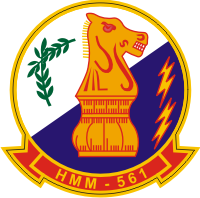|
VMM-561
Marine Medium Tiltrotor Squadron 561 (VMM-561) was a medium-lift squadron of the United States Marine Corps flying the Bell-Boeing V-22 Osprey. Known as the " Pale Horse", it was part of Marine Aircraft Group 16 and based out of Marine Corps Air Station Miramar in California. They were scheduled to move to Okinawa in 2012. The squadron previously served as a training unit during the Vietnam War but was previously deactivated with the retirement of the HUSS from active service. History Marine Medium Helicopter Squadron 561 (HMM-561) was activated on 31 January 1967, to provide refresher training to UH-34 Sea Horse pilots and crews heading to Vietnam. The squadron, based at Marine Corps Air Facility Santa Ana, fell under the command of Marine Aircraft Group 56 and the 3rd Marine Aircraft Wing. Undermanned from the start, the unit remained in cadre status until 9 May 1968 when they were formally stood up. In addition to training, the squadron's mission also included conducting lo ... [...More Info...] [...Related Items...] OR: [Wikipedia] [Google] [Baidu] |
HMM-561 Insignia
Marine Medium Tiltrotor Squadron 561 (VMM-561) was a medium-lift squadron of the United States Marine Corps flying the Bell-Boeing V-22 Osprey. Known as the " Pale Horse", it was part of Marine Aircraft Group 16 and based out of Marine Corps Air Station Miramar in California. They were scheduled to move to Okinawa in 2012. The squadron previously served as a training unit during the Vietnam War but was previously deactivated with the retirement of the HUSS from active service. History Marine Medium Helicopter Squadron 561 (HMM-561) was activated on 31 January 1967, to provide refresher training to UH-34 Sea Horse pilots and crews heading to Vietnam. The squadron, based at Marine Corps Air Facility Santa Ana, fell under the command of Marine Aircraft Group 56 and the 3rd Marine Aircraft Wing. Undermanned from the start, the unit remained in cadre status until 9 May 1968 when they were formally stood up. In addition to training, the squadron's mission also included conducting lo ... [...More Info...] [...Related Items...] OR: [Wikipedia] [Google] [Baidu] |
Bell-Boeing V-22 Osprey
The Bell Boeing V-22 Osprey is an American multi-mission, tiltrotor military aircraft with both vertical takeoff and landing (VTOL) and short takeoff and landing (STOL) capabilities. It is designed to combine the functionality of a conventional helicopter with the long-range, high-speed cruise performance of a turboprop aircraft. In 1980, the failure of Operation Eagle Claw (during the Iran hostage crisis) underscored that there were military roles for which neither conventional helicopters nor fixed-wing transport aircraft were well-suited. The United States Department of Defense (DoD) initiated a program to develop an innovative transport aircraft with long-range, high-speed, and vertical-takeoff capabilities, and the Joint-service Vertical take-off/landing Experimental (JVX) program officially commenced in 1981. A partnership between Bell Helicopter and Boeing Helicopters was awarded a development contract in 1983 for the V-22 tiltrotor aircraft. The Bell Boeing team join ... [...More Info...] [...Related Items...] OR: [Wikipedia] [Google] [Baidu] |
List Of Decommissioned United States Marine Corps Aircraft Squadrons
While other nations have Marine corps, Marines who are aviators, only the United States Marine Corps has its own dedicated aviation arm. Most squadrons have changed names and designations many times over the years so they are listed by their final designation. Squadron designations The basic tactical and administrative unit of United States Marine Corps Aviation is the squadron. Fixed-wing aircraft squadrons (heavier than air) are denoted by the letter "V," which comes from the French verb "Voler" (to fly). Helicopter, Rotary wing (helicopter) squadrons use "H." Marine squadrons are always noted by the second letter "M." Squadron numbering is not linear as some were numbered in ascending order and others took numbers from the wing or the ship to which they were assigned. From 1920 to 1941, Marine flying squadrons were identified by one digit numbers. This changed on July 1, 1941 when all existing squadrons were redesignated to a three-digit system. The first two numbers were suppo ... [...More Info...] [...Related Items...] OR: [Wikipedia] [Google] [Baidu] |


